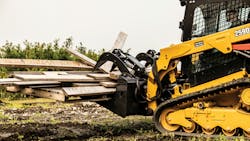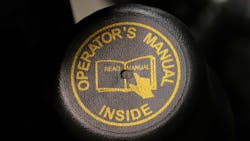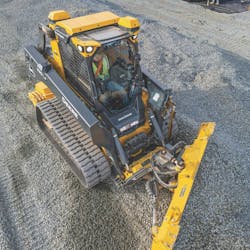Key Highlights
In this article, you will learn:
- How to match attachments to carriers.
- How to do a pre-operation safety check.
- How maintain attachments.
Compact equipment such as mini excavators, skid steer loaders, and compact track loaders provide fleets with utility beyond their primary purpose. Replace a bucket with an attachment, and application opportunities multiply.
The potential for unsafe usage also multiplies, however. The machine may stay the same, but each attachment brings its own set of specifications, such as coupling, power requirements, and operation parameters.
Safe operation of attachments requires additional consideration beyond how to operate the carrier. Expanding utilization cannot end with simply choosing a tool to mount on the machine.
Here, original equipment manufacturers and attachment suppliers recommend five critical areas on which fleets must focus to maximize efficient and safe use of equipment attachments.
Match the attachment to the machine
“[A] frequent misstep is using to wrong tool for the job or using the right tool with the wrong machine,” says Darin Gronwold, product manager for Ignite Attachments. “An attachment that’s too heavy or incompatible with the carrier can throw off balance, strain hydraulics, or reduce braking power. This can be especially dangerous on slopes or in tight spaces.
“Mismatched interfaces can appear connected but fail under load, especially in mixed fleets or rental situations,” he says.
More on equipment safety
- Tips when using excavators for lifting.
- Best practices for telehandler safety.
- Safe trailering tips for compact equipment.
- How to safely operate an excavator.
Emily Pagura, product marketing manager for John Deere, points to the machine’s operator’s manual. “[U]nderstand how the machine needs to be set up and how to operate the attachment as intended. Similarly, it’s important to pair attachments and machines in accordance with manufacturer’s requirements, as this is a common error that can lead to injury or machine damage.”
Kevin Kitchings, inside sales representative at Blue Diamond Attachments, says to check the attachment manual, too. “They are the lifeline of the attachment,” he says. “[T]hough some would say things like, ‘a brush cutter is a brush cutter,’ they can’t go on that premise. Connectors can be different; size and power of host machine plays a part—and that is just the beginning.”
Inspect attachment condition
Pre-operation inspections are common for compact equipment such as skid steers, but those inspections must expand to include the attachments, experts say. Again, owner’s manuals serve as the primary source for these inspections.
Common checks include: confirm the integrity of mount plates and welds; look for bent tines, damaged cutting edges, or missing pins; and inspect hydraulic hoses and fittings.
Frank Gangi, product manager for Yanmar Compact Equipment, adds that an inspection should include protective sleeves, ensuring they are intact and positioned to prevent damage during operation.
Confirm proper attachment coupling
A pre-operation inspection also must ensure that the attachment is properly connected to the host machine. An attachment uncoupling during operation not only endangers the operator, but also those working nearby.
“Attachment separation is one of the most preventable causes of job site injuries and equipment damage,” says Ignite’s Gronwold. “Start by confirming that the attachment is securely latched to the carrier. Always do a visual check: Are both locking pins fully engaged? Then perform a functional check by gently lifting or tilting to make sure the attachment doesn’t shift or rattle.”
“Always ensure your attachment is securely on the machine, no matter what kind of coupler you have or what attachment you’re running,” says Deere’s Pagura. “This is especially important as you change attachments; know what indicators your coupler has, that show that the locking mechanism is engaged.”
Kitchings at Blue Diamond says checking the safety chains is also essential. “They are there for a reason, and if the attachment was to come loose on the machine, that chain will secure it to the point it doesn't get too far from the host machine.”
Yanmar’s Gangi suggests moving the machine to a safe place away from people or other hazards for a quick test. “Tilt the attachment down far enough to visibly check the pin engagement in the coupler to make sure the pins are fully seated in both sides of the coupler plate. Attachments with a bolt-on safety retention bar, such as mulchers, should be physically fastened to the machine to prevent uncoupling when in use.”
Understand attachment operations
Once properly matched and attached, the tool is ready for application. Proper and safe usage starts with the owner’s manual, says Kitchings and Pagura, even if the operator uses the same attachment on the same machine each day.
“It may seem tedious,” says Kitchings, “but all it takes is forgetting one safety check and he or she could be seriously injured. Other things we hear too often are things like not clearing debris off the attachment before starting it up and … moving too fast and not making sure the attachment is ready to be put to work.”
Attachment maintenance
Attachment efficiency and safety, as with the host machine, requires proper maintenance.
“Routine maintenance is one of the most effective ways to ensure attachment safety,” says Gronwold. “A few minutes of upkeep can prevent hours of downtime or worse, a serious incident.”
Beyond daily inspections, operators should grease the attachment per manufacturer recommendations, as well as follow all other maintenance intervals.
“Attachments should be cleaned after each use, paying particular attention to the receiver side for excess material build-up that could prevent the attachment from locking to the machine,” says Gangi.
Also, says Gronwold, don’t ignore storage.
“Storing attachments indoors or on stable surfaces reduces exposure to moisture and other conditions that can accelerate wear,” he says.
About the Author
Rod Sutton
Sutton has served as the editorial lead of Construction Equipment magazine and ConstructionEquipment.com since 2001.
Our mission is to help managers of heavy equipment and trucks to improve their performance in acquiring and managing their fleets. One way we do that is with our Executive Institute, where experts share information and ideas that will enable equipment managers to accurately manage equipment costs so that they can deliver the optimum financial benefits to their organizations.
We also have a laser focus on product development, performance, and technology; as well as equipment acquisition, disposal, and maintenance. Our exclusive Field Tests take earthmoving equipment and truck into the field for professional evaluations.
Check out our free newsletters to see the latest content.
You can find Sutton on LinkedIn.



